Sometimes an image is so engrossing that we can ignore what it’s telling us about its subject and just enjoy the splendour. That’s certainly true of this image of NGC 5068 released by the ESA. But Universe Today readers are curious, and after enjoying the galactic portrait for a while, they want to know more.
NGC 5068 is pretty close for a galaxy. It’s about 17 million light-years away and is face-on from our perspective, making it an optimal object for scientific observations. It’s more than 45,000 light-years across and is a field galaxy, meaning it’s not associated with a galaxy group or cluster. NGC 5068 is kind of alone out there.
The JWST’s view of the galaxy comes from two of its instruments: MIRI and NIRCam. Each of those two instruments captured NGC 5068, and the main image is a combination of the two.
The image shows myriad individual stars, and clouds of gas lit up by the stars embedded in them. While those are stunning, and the JWST’s ability to resolve so many stars is extraordinary, something else draws our attention: the galaxy’s bar, seen in the upper mid-left.

These are the two separate images of NGC 5068 that were combined into the single leading image. On the left is the MIRI image, and on the right is the NIRCam image. Image Credits: ESA/Webb, NASA & CSA, J. Lee and the PHANGS-JWST Team
JWST captured the images as part of the PHANGS (Physics at High Angular resolution in Nearby GalaxieS) program, which studies the multiscale processes of galaxy evolution, star formation, and stellar feedback. PHANGS combines high-resolution observations with the latest theoretical models. The JWST is the latest contributor, but other telescopes like the Hubble and ALMA have already made important contributions to PHANGS.
The idea behind PHANGS is to measure the earliest stages of star formation and feedback. They also want to understand how starlight affected by dust can trace gas and star formation across diverse galactic environments. In short, star formation affects a lot of things, and a better understanding of the entire process will lead to discoveries in other areas of astrophysics and astronomy.
That’s ambitious, but the PHANGS team has made a lot of headway, including recently publishing their 100th paper. The JWST is the latest telescope to contribute, and as these JWST images make clear, PHANGS has more progress and papers in its future.
PHANGS already has a large collection of images and data of things like star clusters, active star-formation regions, molecular clouds and complexes, and star-forming emission nebula. But the JWST is taking PHANGS to the next level. Its infrared observing power can peer through the clouds of gas and dust that hide the star-forming process from other telescopes. One of the JWST’s explicit science goals is to peer into these shrouded regions more effectively than its predecessors.
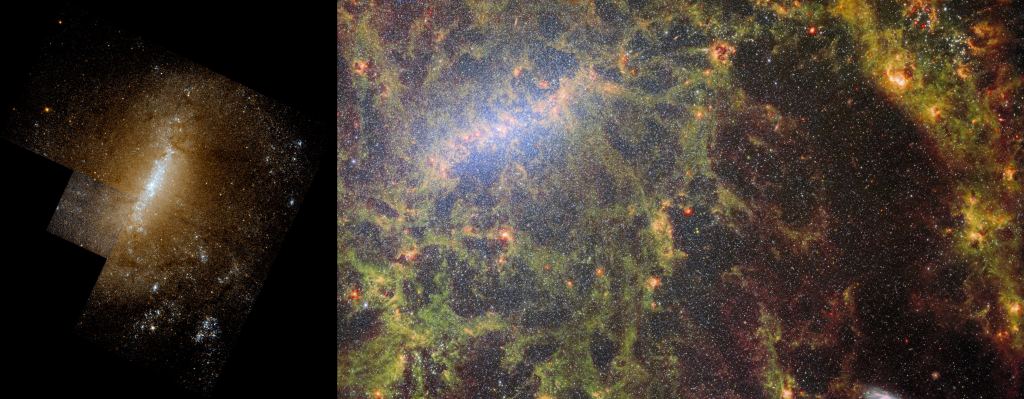
These two images show how powerful the JWST (R) is compared to the Hubble (L). Image Credit: (L) NASA/ESA – The Hubble Legacy Archive (HLA): Space Telescope Science Institute (STScI), the Space Telescope European Coordinating Facility (ST-ECF), and the Canadian Astronomy Data Centre (CADC) – zoranknez (Aladin software). (R) ESA/Webb, NASA & CSA, J. Lee and the PHANGS-JWST Team
Astronomers are interested in barred spiral galaxies like NGC 5068 for a bunch of reasons, but their bars are an area of particular focus. Bars affect the flow of star-forming gas in the galaxy, and astronomers want to better understand the role they play.
Bars have an important job. They channel gas from the spiral arms into the galactic center and trigger star 𝐛𝐢𝐫𝐭𝐡. They also mix material in the inner regions of a galaxy and stimulate radial migration. Astronomers think that the bars are a recurring rather than permanent feature. On a scale of about two billion years, a galaxy oscillates between having a bar and not having one.
There’s some evidence that bars influence what’s called a metallicity gradient, but it’s not conclusive. Metallicity refers to the presence of elements heavier than hydrogen and helium. Everything heavier than hydrogen and helium was created inside stars, while hydrogen and helium have been around since the Big Bang. So metallicity tells astronomers a lot about the nature, age, and composition of a galaxy.
Typically, the stars furthest from the galactic center, in the galactic halo, are older and have the lowest metallicity. Near the galactic center, where the bar channels gas, stars are younger and have higher metallicity. A galaxy’s metallicity gradient describes how the metallicity changes from the galactic nucleus to the central bulge, the disk, the spiral arms, and finally, the halo. The globular clusters on the periphery of a galaxy contain the most ancient stars with the lowest metallicity.
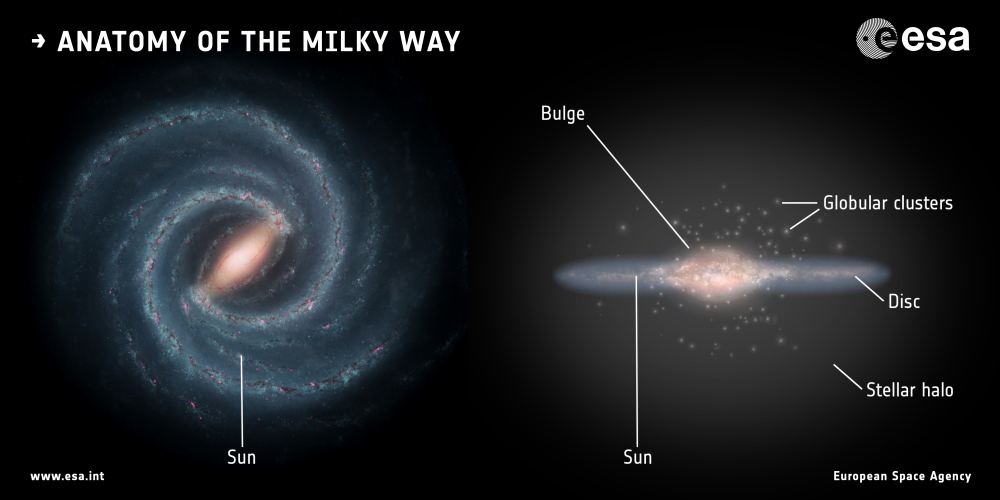
This image shows the anatomy of the Milky Way, also a barred spiral galaxy. Younger stars with higher metallicity exist in the center, while older stars with lower metallicity are in the halo. Image Credit: ESA
The metallicity gradient is an important feature of galaxies like NGC 5068. It’s a measure of how rich a galaxy is in elements heavier than hydrogen and helium and how those elements are spread through the galaxy. The early stages of a galaxy’s evolution leave an imprint on the gradient. When astronomers can plot the metallicity of stars from the galactic center outwards, it creates a gradient.
In the Milky Way, the gradient shows decreasing metallicity from the core to the halo. That’s called a negative gradient. As observing technologies have improved, astronomers have found more detail in the gradients. Barred spirals have a break in the slope, indicating that something shifted as the galaxy evolved. The break in the slope can be shallow, then steep, or steep, then shallow.
NGC 5068 has a ‘shallow-steep’ metallicity radial profile, meaning that the inner stars have similar metallicity, hence, a shallow slope. But the outer stars have more variation in their metallicity, meaning they have a shallow slope in the gradient.
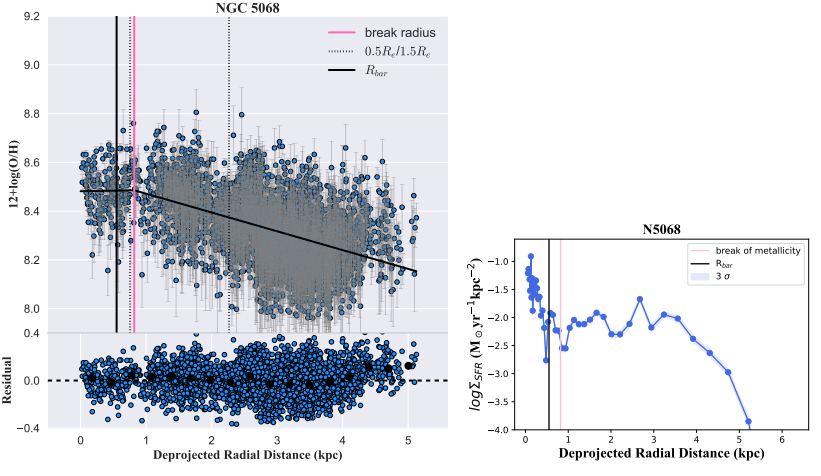
This figure helps illustrate what a metallicity gradient looks like in NGC 5068. It shows the abundance of oxygen, which is considered a metal in astronomy. As the distance from the center of the galaxy increases, the abundance of oxygen decreases. At first, the gradient is shallow, but it drops more steeply with distance. So NGC 5068 has a shallow-steep gradient. Image Credit: Chen et al. 2023.
A 2023 paper showed how NGC 5068’s bar induces gas inflows into the central region. The inflows mix interstellar medium inside the bar region, which flattens the metallicity gradient within the break radius (0.82 kpc). “The nearly flat (?0.005 dex/kpc) inner metallicity gradient is strong evidence for efficient radial migration and material mixing driven by the bar,” the paper states.
While a galaxy’s bar affects the metallicity gradient, there’s no single way that happens. Different barred spiral galaxies show different gradients, so there’s no single common mechanism. There’s a lot going on in a galaxy’s center, and while a bar can channel new star-forming gas into the region and drive star formation, there are also outflows that have their own effect.
These are the types of details that astronomers are trying to understand better with the JWST. But the image is stunning, regardless of how deeply we want to dig into it.
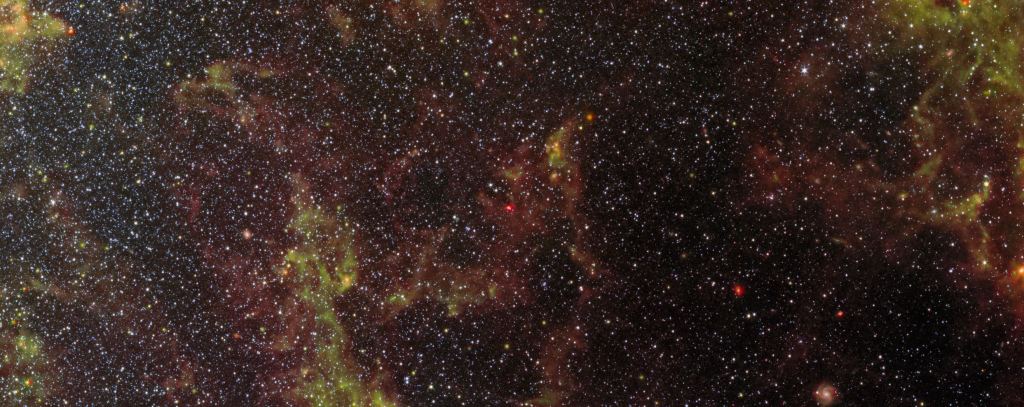
Zooming in on any part of the image brings it to life. It shows a myriad of individual stars and gas clouds and filaments lit up by stars. Image Credit: ESA/Webb, NASA & CSA, J. Lee and the PHANGS-JWST Team
Astronomy is about understanding the cosmos and how we’re a part of it all. But it’s also about wonder and open-hearted awe at the beauty and grandeur of nature.
The JWST is feeding us a balanced diet of both.
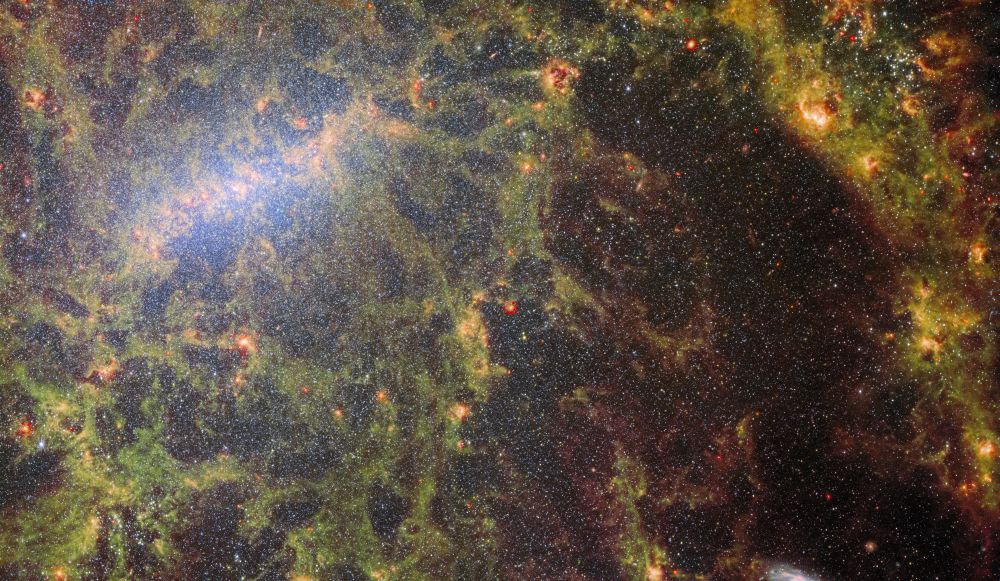
NGC 5068 in all its glory. ESA/Webb, NASA & CSA, J. Lee and the PHANGS-JWST Team
A high-resolution TIFF version of this stunning image is here under download.





